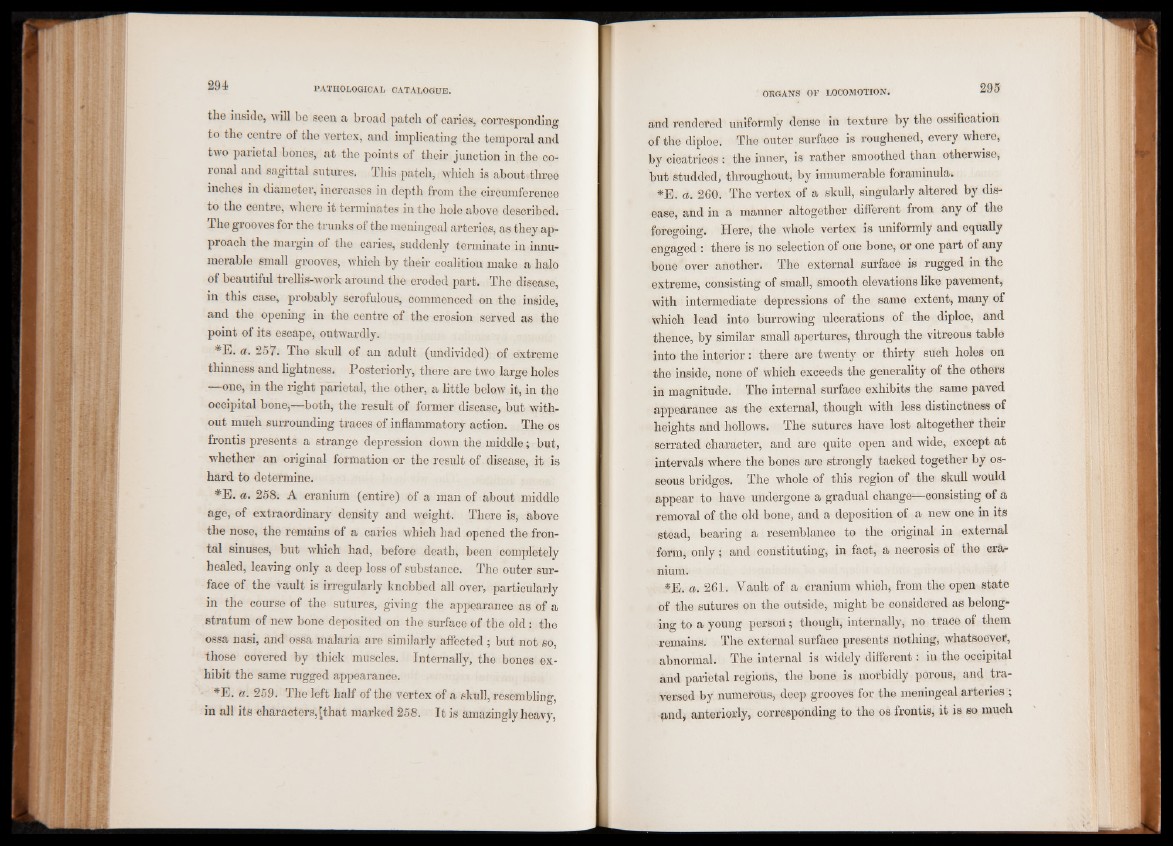
the inside, will be seen a broad patch of caries, corresponding
to the centre of the vertex, and implicating the temporal and
two parietal bones, at the points of their junction in the coronal
and sagittal sutures. This patch, which is about three
inches in diameter, increases in depth from the circumference
to the centre, where it terminates in the hole above described.
The grooves for the trunks of the meningeal arteries, as they approach
the margin of the caries, suddenly terminate in innumerable
small grooves, which by their coalition make a halo
of beautiful trellis-work around the eroded part. The disease,
in this case, probably scrofulous, commenced on the inside,
and the opening in the centre of the erosion served as the
point of its escape, outwardly.
*E. a. 2o7. The skull of an adult (undivided) of extreme
thinness and lightness. Posteriorly, there are two large holes
—one, in the right parietal, the other, a little below it, in the
occipital bone,—both, the result of former disease, but without
much surrounding traces of inflammatory action. The os
frontis presents a strange depression down the middle; but,
whether an original formation or the result of disease, it is
hard to determine.
*E. a. 258. A cranium (entire) of a man of about middle
age, of extraordinary density and -weight. There is, above
the nose, the remains of a caries which had opened the frontal
sinuses, but which had, before death, been completely
healed, leaving only a deep loss of substance. The outer surface
of the vault is irregularly knobbed all over, particularly
in the course of the sutures, giving the appearance as of a
stratum of new bone deposited on the surface of the old: the
ossa nasi, and ossa malaria are similarly affected ; but not so,
those covered by thick muscles. Internally, the bones exhibit
the same rugged appearance.
*E. a. 259. The left half of the vertex of a skull, resembling,
in all its characters, [that marked 258. It is amazingly heavy,
and rendered uniformly dense in texture by the ossification
of the diploe. The outer surface is roughened, every where,
by cicatrices : the inner, is rather smoothed than otherwise,
but studded, throughout, by innumerable foraminula.
*E. a. 260. The vertex of a skull, singularly altered by disease,
and in a manner altogether different from any of the
foregoing. Here, the whole vertex is uniformly and equally
engaged : there is no selection of one bone, or one part of any
bone over another. The external surface is rugged in the
extreme, consisting of small, smooth elevations like pavement,
with intermediate depressions of the same extent, many of
which lead into burrowing ulcerations of the diploe, and
thence, by similar small apertures, through the vitreous table
into the interior: there are twenty or thirty such holes on
the inside, none of which exceeds the generality of the others
in magnitude. The internal surface exhibits the same paved
appearance as the external, though with less distinctness of
heights and hollows. The sutures have lost altogether their
serrated character, and are quite open and wide, except at
intervals where the bones are strongly tacked together by osseous
bridges. The whole of this region of the skull would
appear to have undergone a gradual change—consisting of a
removal of the old bone, and a deposition of a new one in its
stead, bearing a resemblance to the original in external
form, only; and constituting, in fact, a necrosis of the cranium.
*E. a, 261. Vault of a cranium which, from the open state
of the sutures on the outside, might be considered as belonging
to a young persoii; though, internally, no trace of them
remains. The external surface presents nothing, whatsoever,
abnormal. The internal is widely different: in the occipital
and parietal regions, the bone is morbidly porous, and traversed
by numerous, deep grooves for the meningeal arteries ;
and, anteriorly, corresponding to the os frontis, it is so much